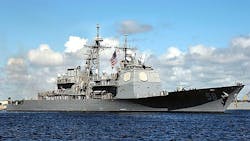Navy EMC2 project seeks to share antennas among radar, EW, and communications systems
ARLINGTON, Va., 12 Nov. 2015. U.S. Navy researchers are trying to build on work done previously in the InTop program to develop new kinds of antennas that communications, radar, and electronic warfare (EW) systems can share.
The idea is to reduce the number of RF and microwave antennas on ships, aircraft, ground vehicles and land sites to mitigate the effects of RF interference, as well as reducing the costs of military systems that use radio waves.
Officials of the Office of Naval Research in Arlington, Va., issued a solicitation last week (N00014-16-R-0012) for the Electromagnetic Command and Control (EMC2) project, which seeks close integration of disparate RF system electronics and antennas to reduce costs and RF interference.
Navy researchers are trying to capitalize on work done in the Integrated Topside (InTop) shipboard antenna program, which sought to develop integrated shipboard RF antennas able to handle several different warfare areas.
The EMC2 program, however, seeks to move beyond InTop by developing and demonstrating system prototypes that integrate the RF functionality of EW, radar, communications, and information operations into a common set of open-systems antennas, electronics, and software.
This is an attempt to head-off widespread development of stand-alone RF and microwave systems that each require a separate antenna. This approach is expensive, wastes space, and often subjects RF systems to interference from the others.
Prototypes should be able to provide several simultaneous and independent RF and microwave beams that can work together to perform EW, radar, communications, and wireless information exchange. Researchers want to integrate these new prototypes with InTop or other RF combat systems.
The goal is to provide these integrated RF and microwave systems with resource allocation, real time spectrum operations, emissions control, and electromagnetic maneuver so that Navy RF systems can work together.
Related: Northrop Grumman chooses Curtiss-Wright digital radio equipment for Navy InTop program
This capability should be able to monitor the RF spectrum across a wide range of frequencies and reallocate functions to the best frequency in response to changes in the electromagnetic environment for intelligence gathering, cyber warfare, command and control, EW, situational awareness, and battle management.
The project will involve establishing open-systems interfaces between system software, firmware, and hardware; develop system prototypes for deployment on surface ships, aircraft, and submarines; and establish the ability to integrate new electromagnetic systems with existing systems.
Companies interested should mail or hand-deliver hard copies of proposals no later than 7 Dec. 2015 to the Navy's Lynn Christian, care of the The Office of Naval Research, 875 North Randolph St., Arlington, VA 22203-1995.
For questions or concerns contact the Navy's Lynn Christian by email at [email protected], or by phone at 703-696-1575. More information is online at https://www.fbo.gov/spg/DON/ONR/ONR/N00014-16-R-0012/listing.html.

